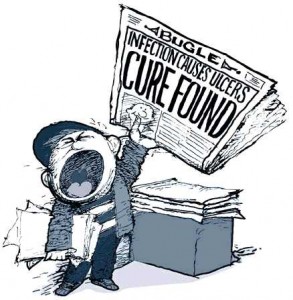The Good “Should”
As you can see at the top of this webpage I have a tab entitled “The Gospel” (I may have changed it’s name by the time you are reading this). Now, at the time I wrote this blog entry there was nothing under “The Gospel” tab as I have been thinking lately about how to explain the gospel in a clear and concise way for a modern audience.
The word “gospel” literally means “good news” and many have pointed out the fact that for people to appreciate and embrace this good news they must know why the news is good. They must know the bad reality in which the context is laid to show that good news in needed in the first place.
appreciate and embrace this good news they must know why the news is good. They must know the bad reality in which the context is laid to show that good news in needed in the first place.
The bad reality is the reality of our sin (our unloving and untrusting indifference and rejection of God) and the distance that creates between us and God making our relationship with God one of estrangement and hostility. If you don’t see our need for forgiveness and the depth of our hopelessness, then you will never be able to delight in the good news that through Jesus’ death and resurrection, God has made a way for hope, forgiveness and reconciliation to be possible. If you don’t think that there is any bad reality, then the good news of forgiveness through Jesus will seem redundant and ridiculous.
This need to explain and express the “Bad Reality” is commonly the first step that many Christians go to when explaining the Christian message.
Famously, the “Four Spiritual Laws” uses this flow, where the first 2 laws explain the “Bad Reality” (God is good and we are bad, putting us under judgement) and then the last two laws explain the “Good News” (Jesus pays for our sin and we can respond to receive forgiveness). Another example of this is the Calvinistic acronym “TULIP“, where the starting point, “T” is the “Total Depravity of Humanity” (which is the problem) and the “U” “L” “I” and “P” focus on the Good News of how God saves us (the solution).
This “problem then solution” focus is common to many religions and philosophies. Pretty much every religion believes in “Bad Reality”.
 Buddhism, for example, sees the world effected by dukkha (suffering) due to our clinging onto illusions.
Buddhism, for example, sees the world effected by dukkha (suffering) due to our clinging onto illusions.
This is their version of the “Bad Reality” and they suggest that freedom from dukkha and true enlightenment can be achieved through meditation and the letting go of those illusions. This is their understanding of “Good News” in the face of “Bad Reality”.
So, in regard to Christianity, it fairly universally understood that you can’t just go around telling people “Jesus Saves!” if people have no idea what they need saving from. An awareness of the “Bad Reality” needs to be felt and acknowledged before any message of “Good News” can be accepted.
The problem is that, in starting with the sinfulness of man in contrast to the holiness of God, the Christian message can seem like primarily a negative voice in the world. We can spend so much time and energy trying to convince people of their sin and need for forgiveness that we can come across as depressing “glass-half-empty” bigots!
The debate over whether humans are fundamentally good, bad or neutral, has been on the table of philosophy since time began, and Christians (at least those who believe in a gospel of salvation) generally feel compelled to fall into the humans are fundamentally bad camp in the fear that if we said that humans are fundamentally good, we would nullify a need for a Saviour and make nonsensical the idea that humans are under God’s just judgement.
As much as it is true that people do need to see the “Bad Reality” of our separation from God, lately I have been reflecting about whether in today’s culture maybe we need to go one further and explain why the “Bad Reality” is actually bad.
This may seem like an endless spiral of defining everything one step back, and this may be a true danger in theory, but in practice, I think it is necessary to do this at least for one more step, as reality is less and less often being seen as “bad”. Modern philosophy is telling us that there really isn’t a problem – not just in our hearts but also in the world we live in. And where there is no problem, no solution in needed.
The Good News about Jesus is now seen, not as God’s glorious solution to the greatest problem we have, but as a crutch for the weak or scared or ignorant, and Christians who bang on about our sinfulness simply come across as judgemental party-poopers.
Sadly, many Christians are now changing the “Good News” to make the whole thing seem more palitable.Judgement is unpopular and sin is non-existent and so the “Good News” changes from being a rescue mission for sinners destined for Hell, to a fluffy self-help program as heart-warming and superficial as an inspirational poster hanging on the office wall.
But for Christian committed to sharing the gospel that Jesus and the apostles preached, we can’t change it or water it down. This means we also can’t stop telling people about the “Bad Reality”, no matter how difficult it is for people to grasp in today’s world that sees our greatest problem, not as sin, but as low self-esteem.
So again I ask, what’s the solution?
Well, the greatest mistake would be to presume that humanity’s difficulty with understanding its own sinfulness is somehow a new idea. This is a problem that God and the writers of the Bible were well aware of and the simplest place to look at what the first point of the gospel should be is to look at the first book of the Bible.
The Bible begins, not with how sinful we are, or how much we need a saviour, but with a picture of how life was designed to be. I call this, The Good “Should”. It is the way the all things should be, and the Bible’s message is that all things originally were good. Read the very first chapter of the Bible and this message comes across loud and clear.
Creation is good and life is good.
Pleasure is good, sex is good, marriage is good, masculinity is good, Â femininity is good, food is good, animals are good.
We live under God’s good rule and enjoy a harmonious relationship with God, the world and each other, and all of this is good. It is the good “should”.
I think it may be more and more important for us to explain and defend this picture as the way life should be, as a starting point for explaining the gospel.
It can no longer be simply expected that people understand or feel that being “at peace with God” is important or desirable. Along with cynical post-modernism came a dark view of the world which tried to embrace the hopelessness and emptiness of the “Bad Reality” and make out that there was nothing “bad” about it. It was just reality.
If the reality we live in is not bad, then once again, the idea of “Good News” becomes irrelevant.
As pointless as it may be to say, “Jesus saves,” if people don’t understand the problem of sin, it is also pointless to say “You’re a sinner, but Jesus saves” Â if people don’t see that sin or rebelling against God’s rule, is really that big a deal.
 We need to give people a glorious picture of the beauty and goodness of a right relationship with God. This has to be the first painting on the canvas. Once this picture is clear then the gravity and ugliness of the black paint of sin and death will hopefully be able to be seen. The Good News then, paints a new picture over the top of all this.
We need to give people a glorious picture of the beauty and goodness of a right relationship with God. This has to be the first painting on the canvas. Once this picture is clear then the gravity and ugliness of the black paint of sin and death will hopefully be able to be seen. The Good News then, paints a new picture over the top of all this.
I know that saying “We should be in harmony with God, but you’re a sinner, but Jesus saves” just adds one more premise that people will object to, but ultimately, if people can’t see that all people should be able to say that they know God and are at peace with him, then all the rest won’t make sense.
If people reject the “Good Should” then they will naturally re-interpret the “Bad Reality” and consequnetly never be able to rejoice in the “Good News”.
(1642)



Two Ways To Live starts that way. (http://www.matthiasmedia.com.au/2wtl/2wtlonline.html) It’s possible it doesn’t talk enough about the good – the way things ‘should’ be – or maybe we tend to rush over that bit to get to the Jesus bit… hmmm. Might be worth spending more time on the first bit…